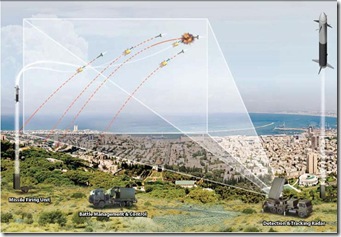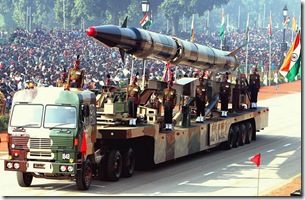JASSM in trouble again
ELP points to a report that the troubled JASSM tactical cruise missile is again facing the prospect of program cancellation if its performance & reliability (last reported to be under 60%) do not improve in future tests.

This is a future prospect to watch out for. JASSM is supposed to be USAF’s primary door-kicker against a sophisticated IADS (along with high-end VLO assets like the B-2 and F-22, plus whatever CALCM stocks are still around). If the missile proves not to be up to the task, and CALCM cannot be counted upon or runs out, the USAF will have to rely exclusively on manned aircraft for the job – or worse, ask the USN to clear a path for them with TLAM strikes.
Because of this program’s importance, it may be likely that the necessary funding for further development will be allocated, even at the cost of stripping other ongoing projects.
Iron Dome to be deployed by 2010
Kobus points to a Jerusalem Post article that claims that the Israeli Iron Dome ATBM system will be deployed by 2010.
According to the same article, Iron Dome’s deployment is part of a multi-phase deployment of defences against ballistic missile and tactical rockets:
A second system, called David’s Sling and under development by Rafael and Raytheon to intercept medium-range rockets, would be operational within four years, he said. Shortly afterwards, the Arrow 3 – an advanced version of the current long-range system in IAF operation – would be declared operational.
What kind of OPFOR is Venezuela?
Jewel of an article: Separating Fact from Fiction: An Analysis of Venezuela’s Military Power
Found this via Kobus at NOSINT
Things that stick out…
The Myth of Equality among the Chávez-era Armed Forces
The events of April 2002, namely the coup that briefly ousted Hugo Chávez from power, are important in order to understand how he has striven to re-organize a military hierarchy ever since. Analyst Rocío San Miguel argued that “the Bolivarian armed forces have gone from a de-professionalization to an open ‘politization’ to almost ‘praetorianism.’” The Venezuelan specialist further argues that around 200 hardcore Chavista military officers are in control of the armed forces’ most sensitive positions. In addition, Chávez openly has given preference to the army (himself being a former army officer) above the other branches of the military. For example, the newly acquired Sukhoi planes and the Mi helicopters are under the control of the army, not the air force.
Wonder what the relationship is between the Army’s AF and the AF? Is this similar to Iranian Army vs. Pasdaran in that there may not be much direct coordination at the lower levels at all?
Certainly makes me think about how I’d model them in a sim or a game.
Weapons Galore
Venezuela also has declared its intention to purchase a number of Russian-made warships and submarines, but as of yet no deal has been agreed upon. An October 2008 report by United Press International explained that Chávez aims to purchase at least three diesel-powered Varshavyanka (NATO designation Kilo) class submarines. However, such rumors have been in circulation for quite some time now. It was previously thought that Venezuela would strive to acquire as many as half a dozen such submarines, but recent reports have scaled back the number to just three. It is unclear if even this reduced order will ever materialize or be scuttled.An April 2009 report by Nabi Abdullaev in DefenseNews points out that Caracas plans to acquire several dozen surface warships, including Project 14310 Mirage patrol boats, which are floating missile platforms designated to engage any adversary from a distance of seven to 130 kilometers. Other speculations include that Venezuela also seeks to acquire the new Russian-made Su-35 fighter aircraft as well as 20 or 30 TOR-M1 9M330 missiles.
In mid-April 2009, President Chávez announced that he had acquired a number of Russian-made surface-to-air missiles, namely the Igla SAM systems. According to reports, the portable missiles weigh 42 pounds and can reach 19,500 feet. However, the Russian arms-exporting monopoly, Rosoboronexport firm, quickly declared that no such deal had been agreed upon. Nevertheless, in
discussion with COHA, an analyst at the Federation of American Scientists pointed out that “the missiles on display during a recent military parade appear to be advanced Igla-S (SA-24) MANPADS, not first generation SA-7 Grails.” The footage (which is available in YouTube at http://www.youtube.com/watch?v=u_XT0nzvIGQ regarding a military parade held on April 19, 2009) appears to show dozens of Iglas, according to the FAS analyst.
Speaks for itself.
Water hoses as anti-pirate cannons
Bill Sweetman looks at an interesting proposal by Raytheon and Unifire to use existing fire-fighting equipment abord cargo ships to fend off pirate attacks. Raytheon’s added value is modifications to the navigations radar to enable it to track small incoming boats. The water hoses are claimed to be able to disrupt RIBs at over 100 meters.
A potentially attractive concept for cargo ships that desire an effective piracy countermeasure without actually being armed with firearms (which creates all sorts of legal ramifications).
Agni II to be tested on May 19
Reportedly the Agni II MRBM is to be tested on May 19, an important step towards IOC for this important new missile.
Hat tip: Kobus








